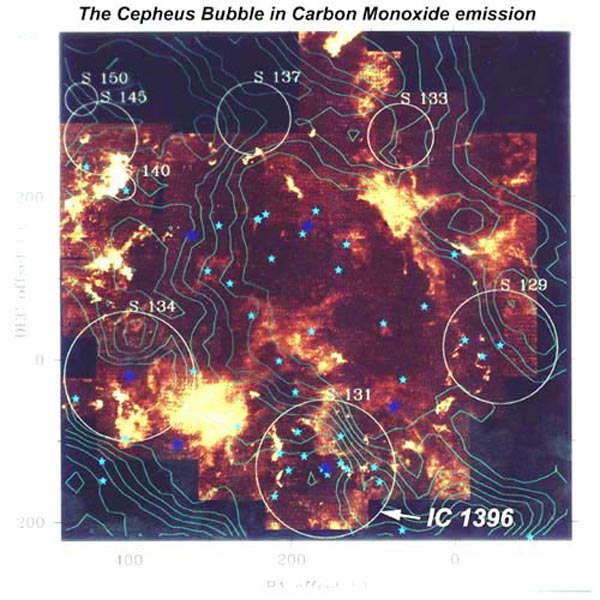|
Astronomy
Home Page
Other Astronomy Pages
Astrophotographer
Portraits Page
Astroimage Index
Bright Nebulae Dark
Nebulae Galaxies
Solar System
Star Clusters Star Fields
SNR
The Astronomy Division is divided into two
sections
x
1. Astroimage
index:
a photo gallery
of some of my astrophotos
x
2.
Astronomy
Home Page:
this page has information on the Cepheus
Bubble and ancient star clusters
Research
papers can be found by searching for them at the
Astronomical Data Service:
|
|
The Cepheus Bubble (molecular cloud):
x
|
|

|
The Cepheus Bubble
is a large molecular cloud in the northern constellation of
Cepheus. It measures about 10 x 10 degrees or 120 parsecs in
diameter, based on a distance from earth of 800 pc. This ring or
bubble of infrared emission was discovered by Kun, et. al. in
1987. A similar structure appears in an older Hydrogen-alpha
photographic atlas of Sivan in 1974. The region is seen in the
visual spectrum to outline Sharpless H-alpha regions including
nebulae IC 1396 (Sh2-131) and Sh2-140. The total gas mass is
estimated at 400,000 solar masses. The bubble is thought to have
been formed in 3 phases (Patel, 1998). Members of earlier
generations of massive stars (which have since gone super nova)
in NGC 7160 are responsible for the origin of the Cepheus
Bubble. These stars created an expanding compressed shell of gas
that became gravitationally unstable at an age of 7 million
years. The members of the Cepheus OB2 association of stars
comprise the second (intermediate) generation of stars in this
region that formed as a consequence of this instability.
Numerous IRAS point sources (current new star formation)
represents the third and youngest generation of stars in this
region. Consequently, evolution of the
Cepheus Bubble and its stars is thought to result from
sequential triggering. At present a major cause for star
formation may be do to radiative implosion from hot stars on
globules in this region. The image here is courtesy of N. Patel
(Harvard-Smithsonian Center for Astrophysics). It shows Carbon
Monoxide emission of the molecular cloud as yellow to white,
atomic Hydrogen as green contour lines and B-type and O-type
stars as blue and cyan star-shapes, respectively. The optically
visible Sharpless emission nebulae are marked. IC 1396 is seen
to form the southern border of the molecular cloud. Imaging was
done using the 14 meter
FCRAO
dish telescope and the
QUARRY
receiver. North is up.
References:
1. Kun, M., et. al., Ap&SS, 134:211, 1987.
2. Sivan, J.P., A&AS, 16:163, 1974.
3. Patel, N., et. al., Origin and Evolution of the Cepheus
Bubble, Astrophysical Journal, 507:241, 1998.
|
The Ancient Open Clusters
Old open or galactic star clusters in our Milky Way galaxy serve
as excellent probes of the structure and evolution of the galactic
disk. Cluster spatial and age distribution help in understanding
the processes of cluster formation and destruction that allow old
clusters to survive. Old open clusters that span a large range in
distance and age are used to define disk abundance gradients and
the cluster age-metallicity relationship. They point to a complex
history of chemical enrichment and mixing within the disk. Old
open clusters are richer and more concentrated than younger ones.
They are thought to have survived because of their large mass,
higher central concentration and their orbits that avoid the
disruptive influence of large molecular clouds. Cluster age
determination may be related to reddening, metallicity and
morphology . James and Phelps (1994) developed a Morphologic Age
Index (MAI) used for determining the age of these old clusters.
The oldest known open cluster is
Berkeley 17
in Auriga. Its age (MAI) of 12.6 billion years approaches that of
some globular clusters. This estimate also slightly exceeds some
of the younger estimates of the age of the universe !
To my knowledge this image of Berkeley 17 is the first color one
made.
References:
1. Friel,E.D., The Old Open Clusters of the Milky Way, Annu. Rev.
Astron. Astrophys., 33:381, 1995.
2. James, K, and Phelps, R., Astron. J., 108:1773, 1994.
Table of some old open clusters
Cluster's name Age (MAI) in billions
of years
CR 261 9.5
NGC 188
7.2
M67 6.3
All of the images and text on these pages are © Copyright 2000 by
Michael A. Stecker, unless otherwise noted. All rights reserved.
They may not be reproduced, published,
copied or transmitted in any form, including electronically on the
Internet or World Wide Web, without written permission of the
author. Thank you for respecting my rights
protected by the Copyright laws of the United States and new
International
Copyright treaty.
|
| |
| |
|
|
|